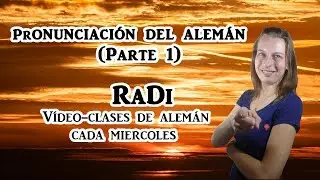German Pronunciation (Part 3) - Modified Vowels in German ♂ UMLAUTE ♀
Today we will learn!
Vowel modifications, which in German are known as Umlaute.
Do you know how to pronounce these letters (ä), (ö), and (ü)?
As we can see, they resemble the vowels (a), (o), and (u), but they have a small modification.
Well, they have an umlaut above them.
Therefore, they cannot be pronounced as in Spanish, and in this video lesson, we will learn how to pronounce them correctly.
The letter (ä) is the easiest; it's like an e, but you just open your mouth a little wider. Then we make the Ä sound.
Repeat after me: Ä
To pronounce this letter: (Ö) we form an o with our lips, but we won't pronounce it. We pronounce the e. Then we make the Ö sound.
Repeat after me: Ö
To pronounce this letter: (Ü) we form a u with our lips, but we won't pronounce it. We pronounce the i. Then it would be Ü.
Repeat after me: Ü
By learning to pronounce these letters, we could go to a restaurant and order a breakfast with cheese.
So, if we walk into a restaurant in Germany, the waiter greets us and asks:
♂Guten Morgen!, Was wünschen Sie?
Which in English means: Good morning! What would you like?
We could answer:
♀Ich möchte ein Frühstück mit Käse.
Which in English means: I want a breakfast with cheese.
Let's learn to pronounce this phrase:
♀Ich möchte ein Frühstück mit Käse, repeat after me: ♀Ich möchte ein Frühstück mit Käse.
And it's almost certain that the waiter or waitress, with typical German discipline, will answer:
Es kommt sofort!
Which in English means: "It's coming right away!"
Let's look at the everyday use of the expressions we've learned:
♂Guten Morgen!, Was wünschen Sie?
♀Ich möchte ein Frühstück mit Käse.
♂Es kommt sofort!
In this video lesson, we learned:
To pronounce the letters:
Ä
Ö
Ü
And knowing that, we also learned how to order a breakfast with cheese, so now we know how to say:
♂Guten Morgen!, Was wünschen Sie?
♀Ich möchte ein Frühstück mit Käse.
♂Es kommt sofort!



















